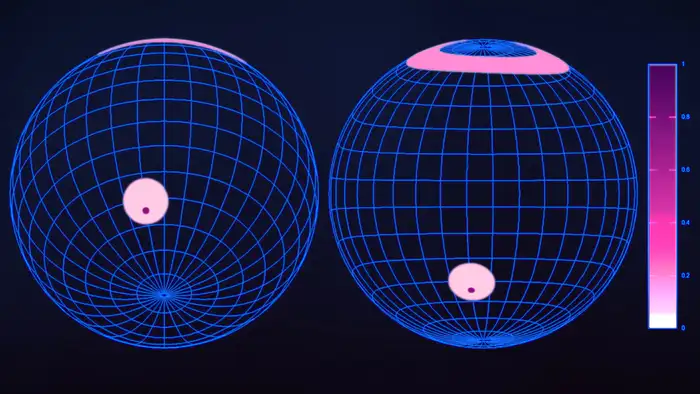The nearest millisecond pulsar, PSR J0437-4715, has a radius of 11.4 kilometers and a mass 1.4 times that of the Sun. This is the result of precision measurements made by a team of researchers led by the University of Amsterdam (the Netherlands).
The measurements reveal more about this neutron star’s composition and magnetic field. The researchers are publishing their findings in a series of scientific papers.

Millisecond pulsar PSR J0437-4715. On the left as seen from Earth. On the right as seen from the star’s equatorial plane. The purple-pink color indicates the temperature of the hot spots at the poles. White is relatively cool. Purple is hot. The hot magnetic poles are not exactly opposite each other. Image credit: NASA/Sharon Morsink/Devarshi Choudhury et al
PSR J0437 is a pulsar, a rotating neutron star that emits electromagnetic radiation. It is located about 510 light-years from Earth in the southern constellation of Pictor. PSR J0437 rotates 174 times per second around its axis and has a white dwarf companion. Like an out-of-control lighthouse, the pulsar sends a beam of radio waves and X-rays toward Earth every 5.75 milliseconds. This makes it the closest millisecond pulsar to Earth. It is also, in part because it is so close, the brightest millisecond pulsar. And it is a more stable clock than man-made atomic clocks.
Dutch national supercomputer
For their research, the scientists used data from the NICER X-ray telescope aboard the ISS. They combined the X-ray data with a technique called pulse profile modeling. To do this, they computed complex statistical models on the Dutch national supercomputer Snellius. In the end, they were able to calculate the star’s radius, with the help of mass measurements made by Daniel Reardon (Swinburne University of Technology, Australia) and colleagues at the Parkes Pulsar Timing Array. They also mapped the temperature distribution of the magnetic poles.
Principal investigator Devarshi Choudhury (University of Amsterdam, the Netherlands) is pleased with the measurements: “Before, we were hoping to be able to calculate the radius accurately. And it would be great if we could show that the hot magnetic poles are not directly opposite each other on the stellar surface And we just managed to do both!”
Maximum weight
The researchers report that the new measurements indicate a “softer equation of state” than previously thought. By that, they mean that the maximum mass of neutron stars must be lower than some theories predict. “And that, in turn, fits nicely with what observations of gravitational waves seem to suggest,” said co-author and neutron star expert Anna Watts (University of Amsterdam).
Source: University of Amsterdam

